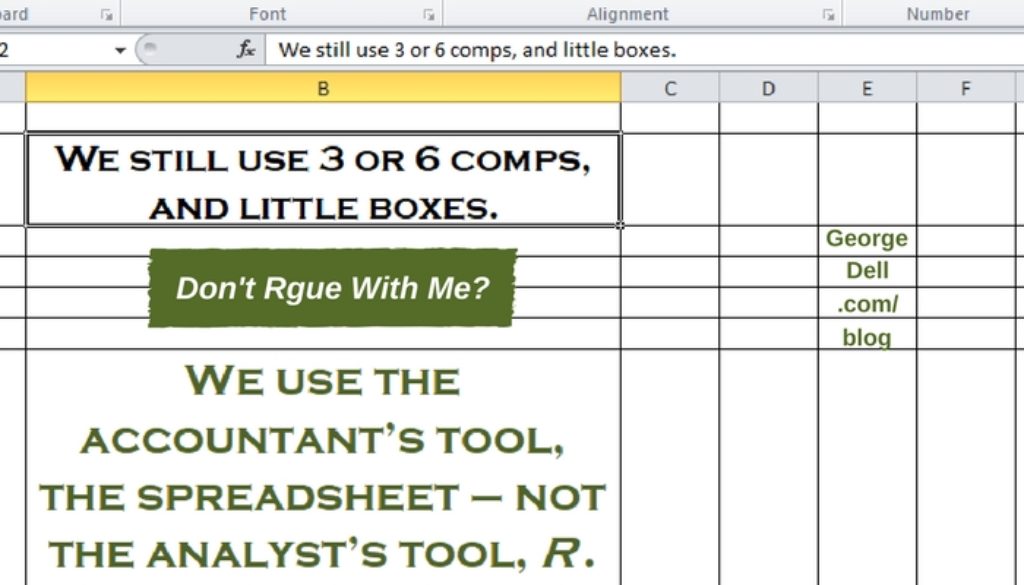The appraisal profession is hamstrung. Who did this to us? Looking for cause?
When things feel and act difficult, it is only human to look at cause. It is them who create problems. If only they would see things our way.
If we took a poll, who is it that is causing us the biggest problems? Is it the regulators? The reviewers? The AVMs? AMCs? The licensers? Fannie Mae? Court rulings? Our Standards? The Appraisal Foundation? Professional organizations? Out-of-data education? Our software? Or the ‘skippies’ – marginally ethical competitors? Whew!
Is it all of the above? Some of the above? Or is everything just hunky-dory until I retire?
Unless we are an involved part of any of the above, we have little direct influence on changing things.
Only one question remains. Only one question is relevant. That question is: “What can we do?” “What can I do?”
I believe that psychologists would say that a focus on “What can I do?” helps mental health.
What is the problem, and what can I do to make things better? What can I do to be happier, feel better about my work, and my place in the world?
Of the above list, it’s our main tool that we can change. It is our software. Our software is all about tables. Little boxes of comps and features. Boxes of variables and cases. The cases are the comps, and the variables are the features: the sq.ft., the site, the parking, the rate, the ratio, and even the ‘appeal.’
Our software has itself been influenced from the outside. Them again. The software has to follow the old pattern of cases and features. Just as we have to follow the boxes. On the residential side, our forms still dictate that variables are horizontal, and comps are vertical, different from all known statistical and business databases. We continue the tradition established of three comps on a page – because it fits on an 8½ x 14 sheet of paper, vertically. On the non-residential side, appraisers did turn to the spreadsheet “landscape” view. It became easy to put 7 or 8 comps across, and list the ‘adjustment’ rows in the right sequence (rights, financing, location, time, rates/ratios, and features).
And the data still comes in letter-size pages, or in spreadsheet form. The spreadsheet copies the database analytic format of cases on the rows, and variables on the columns. Then we immediately pivot the data to the old way — columns = comps, rows = variables. Immediately. Habit. Convention. “We’ve always done it that way”
Changes, Changes
The changes we see today are technologies: instant, complete data and analytics software. Appraisers take advantage of neither. We still use 3 or 6 comps, and little boxes. We use the accountant’s tool, the spreadsheet – not the analyst’s tool, R.
R is the most widely used analyst’s package in the world. Yet few appraisers have heard of it. Today’s software enables clearer thinking, better analysis, and convincing reporting – freed of the little boxes. This is why we introduce R in our classes “Stats, Graphs, and Data Science1.” Freed of the mental restriction of the bookkeeper’s tool, the software matches how appraisers really think. And help enhance that analyst thinking. And help explain the opinion to the client. A good thing.
In today’s San Diego Union-Tribune paper, there was an article about jobs and technology. A short paragraph in that article, by Phil Blair in “Career Advice.”
As our tools improve, technology magnifies our leverage and increases the importance of our expertise, judgment, and creativity. . . .Could you find yourself being replaced by automation? What skill sets are you developing today that may be automated within your work life? Are you willing to adapt to the new qualifications?
Are you willing?

September 27, 2017 @ 7:20 am
I am willing to take analysis to the level where it belongs, R you?
See you in San Diego in December when there will be R in the month.
September 27, 2017 @ 7:59 pm
If we cannot be at your live class is there a way to learn how to use this “R”?
September 28, 2017 @ 2:11 pm
First you have to learn how to talk like a pirate. When you’ve mastered that I recommend you watch the latest webinar from RStudio – “Tidyverse, Vizualization and Manipulation Basics” here: https://www.rstudio.com/resources/webinars/ . It will give you a clear outline of what R is about. Learning R is doing R, and while you’re waiting to catch George’s Intro to R course I recommend trying some Datacamp interactive courses https://www.datacamp.com/.
September 28, 2017 @ 7:37 am
We are doing two things in our office to help against automation. One is that we are getting experienced with highly complex properties that will be more difficult to automate and we are branching into other non-appraisal services. We are learning and using statistics in our practice, but automation will still come. It feels distant now, but one day, probably sooner than later, appraisers will all look around and think, “Where did all the work go?”
September 28, 2017 @ 7:46 am
All right then, what’s to be done with the skill set and experience that we have acquired? Even worse, what’s to be become of us as we have painted ourselves into a “career corner” in which HR departments do not regard our skill sets a being transferable to other occupations or professions?
March 28, 2018 @ 5:48 am
I’ll be speaking with local appraisers next week to generate an interest list about offering your class in Ventura/Santa Barbara Counties.